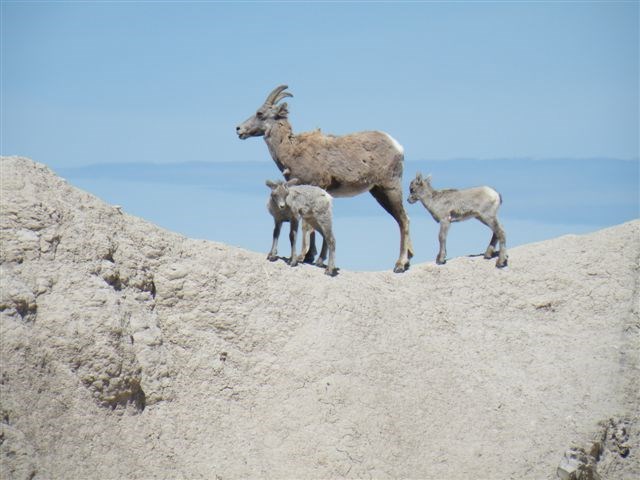Part of a series of articles titled Wildlife in the Badlands.
Article
Bighorn Sheep in the Badlands

NPS Photo

Where do Bighorn Sheep come from?
Wild Siberian sheep likely crossed the Bering Land Bridge to North America over 100,000 years ago. These were the ancestors of the Bighorn Sheep that we see in the park today. Over the course of thousands of years, they gradually migrated south into the US and occupied a native range stretching from Canada to Mexico. Some Native American tribes hold bighorn sheep in high esteem, like the Crow people, who named Bighorn Canyon in Montana after Big Metal, a legendary bighorn with hooves and horns made of glistening steel.
Although there were about 2 million bighorn before their decline, European expansion into the American West caused bighorn populations to plummet to just 20,000 by 1940. These bighorn were dying off due to changes in land use, hunting for sport, and susceptibility to disease. Luckily, conservationists stepped in to defend the species. One such conservationist was Peter Norbeck, the US senator for whom Norbeck Pass is named. He organized the first translocation of bighorn sheep to South Dakota when Custer State Park received 8 bighorn from a Canadian herd in 1922. In 1964, the Badlands received its very own herd of bighorn! Twenty-two bighorn were translocated from Pike’s Peak in Colorado to the Badlands. The park later received a second population in 2004 from Wheeler Peak in New Mexico. The park now serves as a home for about 250 bighorn out of the 80,000 which exist in the US today.

NPS Photo
A Day in the Life
Bighorn sheep live in separate groups based on their sex and age. Lambs and ewes live in large herds. Lambs nurse for up to 6 months. If the lamb is female, it will stay with its mothers herd throughout its life. If the lamb is male, however, it will leave its mothers herd at the age of about 2-4 and seek out a bachelor group. Bachelor groups of rams can consist of up to 10 rams and are typically led by a dominant ram whose dominance is established during rut.
Bighorn are grazers, eating grasses and shrubs. After descending to grasslands to quickly eat large amounts of vegetation, bighorn will then retreat to cliffs away from predators. On these cliffs, bighorns regurgitate their food and chew it as cud before digesting it fully. Bighorns have a complex four-chambered stomach which allows them to get nutrients from hard, dry forage.
Although predators are a problem for many wild bighorn throughout the country, the bighorn in Badlands National Park are very lucky. There are few to no natural predators of adult sheep in our park. This means that the most common way for bighorn to die is by accident or by disease. When sheep die by accident, it is typically when a lamb missteps while climbing or descending a slope and takes a fatal fall. When sheep die from disease, it’s commonly pneumonia or epizootic hemorrhagic disease (EHD).
Last updated: November 10, 2020
